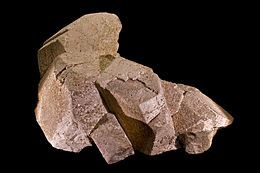| Orthoclase | |
|---|---|
 | |
| General | |
| Category | Silicate mineral |
| Formula (repeating unit) | KAlSi3O8 |
| IMA symbol | Or[1] |
| Strunz classification | 9.FA.30 |
| Crystal system | Monoclinic |
| Crystal class | Prismatic (2/m) (same H–M symbol) |
| Space group | C2/m |
| Identification | |
| Color | Colorless, greenish, greyish yellow, white, pink |
| Crystal habit | Can be anhedral or euhedral. Grains are commonly elongate with a tabular appearance. |
| Twinning | Typically displays Carlsbad twinning. Baveno and manebach twins have also been reported in orthoclase. |
| Cleavage | Has perfect cleavage on {001} and good cleavage on {010}. Cleavages intersect at 90°. It can be difficult to see cleavage in thin section due to orthoclase's low relief. |
| Fracture | Uneven |
| Mohs scale hardness | 6 (defining mineral) |
| Luster | Vitreous, pearly on cleavage surfaces |
| Streak | White |
| Diaphaneity | Transparent to translucent |
| Specific gravity | 2.55–2.63 |
| Optical properties | Biaxial (−), 2V = 65–75 |
| Refractive index | nα = 1.518–1.520 nβ = 1.522–1.524 nγ = 1.522–1.525 |
| Birefringence | 0.0050–0.0060 |
| Dispersion | Relatively strong |
| Extinction | Parallel to cleavage |
| Length fast/slow | No slow or fast length |
| Diagnostic features | Distinguishable from microcline by a lack in gridiron twinning. Distinguishable from sanidine by a larger 2Vx. |
| Other characteristics | Low negative relief; alters to sericite or clay (commonly) |
| References | [2][3][4] |
Orthoclase, or orthoclase feldspar (endmember formula KAlSi3O8), is an important tectosilicate mineral which forms igneous rock. The name is from the Ancient Greek for "straight fracture", because its two cleavage planes are at right angles to each other. It is a type of potassium feldspar, also known as K-feldspar. The gem known as moonstone (see below) is largely composed of orthoclase.
- ^ Warr, L. N. (2021). "IMA–CNMNC approved mineral symbols". Mineralogical Magazine. 85 (3): 291–320. Bibcode:2021MinM...85..291W. doi:10.1180/mgm.2021.43. S2CID 235729616.
- ^ "Orthoclase: Orthoclase mineral information and data". www.mindat.org. Retrieved 17 April 2018.
- ^ "Handbook of Mineralogy" (PDF).
- ^ Barthelmy, Dave. "Orthoclase Mineral Data". www.webmineral.com. Retrieved 17 April 2018.